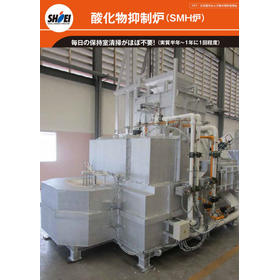Development, design, and prototype support for carbon heating furnaces exceeding 2,000℃.
We provide development and design technology for heating furnaces and heating systems with 30 years of experience in drawing furnaces and vitrification furnaces for optical fibers.
I was a member of the Corporate Production Technology Department at Furukawa Electric Co., Ltd. for 26 years, serving as the head of the Production Technology Development Center for five years. My main responsibilities included the development of optical fibers and the introduction of equipment into mass production lines, and the equipment I introduced is still actively in use today. From the late 1980s, when I was in charge, until the collapse of the telecommunications bubble, the drawing speed of fibers increased every year, and the diameter of preforms also grew larger. At that time, the purchased drawing furnace frequently experienced water leaks, which led us to develop our own drawing furnace. Since there was no design technology for furnaces within the company, we requested a furnace manufacturer we were associated with to design and manufacture the heating furnace. However, water leaks occurred within a few months. Even when the power to the heating furnace was turned off, the inside of the furnace was still glowing brightly, and I, being on-site, felt quite uneasy. Therefore, I decided to design the heating furnace myself. I incorporated knowledge from the development of vacuum deposition equipment for the pressure resistance, airtightness, and leak testing specifications, and I reviewed the welding structure in consultation with the manufacturer. Additionally, I re-evaluated the system and included it in the specifications. At that time, I was too busy to compile everything into systematic documentation. So, after becoming independent, I organized my knowledge as design technology for the carbon heater heating system.
Inquire About This Product
basic information
Overview of Design Technology for Carbon Heater Heating Systems The design will vary based on specific cases (purposes, applications, sizes, etc.) from item 5 onwards. 1. Design of major components such as the heating furnace casing, welding design, and inspection methods 2. Waterway design 3. Simple thermal calculations (design of power capacity, insulation materials, cooling water volume, etc.) 4. Design of the resistance value of the carbon heater 5. Electrode design 6. Design of the cooling water system 7. Design of the air supply and exhaust systems 8. Operating mode design 9. Design guidelines for flow within the furnace (considering product quality) 10. Temperature control and temperature distribution measurement methods Main Specifications of the Carbon Heater Heating Furnace (1) Maximum temperature: 2,500℃ (2) Heater: Insulation material: Carbon heater / Carbon-based molded insulation material (3) Furnace body structure: Water-cooled jacket (4) Furnace body material: Stainless steel (5) Temperature control: Radiation thermometer (control range 1,700℃ to 2,500℃) (6) Heating atmosphere: Reduced pressure, inert gas (7) Vacuum exhaust: Below 10^(-2) (ultra-high vacuum is not included) (8) Gas supply system, vacuum exhaust system, cooling water system: Based on required functions and furnace body design. (9) Operating modes: Standby, heating up, operation, vacuum drawing, etc. Based on requirements.
Price information
Contents of the Technical Advisor Agreement 1. Explanation of the Challenges We will exchange opinions on what activities would be effective and efficient for the consulting company. 2. Finalizing the Contract Details (1) Theme of the Activities (2) Activity Details (number of visits, materials to be submitted, etc.) (3) Contract Duration (4) Determine the contract amount and conclude the agreement. 3. Implementation of the Contract 4. Service Pricing For contracts longer than 6 months: 1 visit/month: 280,000 yen/month (Travel and accommodation expenses separate) For less than 6 months, consult individually.
Price range
P3
Delivery Time
Applications/Examples of results
【1】Applications that require heating to around 2,000°C include: 1) Fiber optic drawing furnaces 2) Manufacturing equipment for carbon fibers 3) Melting furnaces and crystal growth furnaces for SiC and GaN 4) Melting and sintering furnaces for ceramics and so on. 【2】Atmospheric furnaces above 1,000°C A) Glassification furnaces for fiber optics (atmospheric pressure, halogen atmosphere) B) Thermal CVD furnaces (film formation of Si and GaN, atmospheric pressure/vacuum, hydrogen atmosphere + toxic gases) and so on.
catalog(1)
Download All CatalogsCompany information
The D&T Lab focuses on supporting research, development, design, and prototyping for manufacturing process engineering (design) and production technology development (technology). Particularly in the case of new businesses, it is necessary to introduce technologies that the company does not possess and to select and collaborate with partner companies. By utilizing so-called open innovation, we aim to shorten the marketing and product/service development periods, facilitate early entry into new fields and applications, and establish a unique strategy for the company using that information and technology to promote the business in earnest. Once we reach that stage, operations can be managed similarly to existing businesses. Therefore, the challenges of new ventures depend on how efficiently and effectively we design the entry stage. At that stage, it is necessary to gather information and technologies that the company does not possess and to make choices that are suitable for the company. I have experience in the development and launch of mass production equipment and the introduction of new products into factories. From the successes and failures I encountered, I have learned how to design mass production lines and introduce new products in my own way. Additionally, I possess processing techniques for various materials such as copper products, compound semiconductors, quartz glass, and plastics. I will contribute using the insights gained from these mass production technologies and material processing techniques.










![Single End Radiant Tube Burner [TRF Burner]](https://image.mono.ipros.com/public/product/image/c08/2000793597/IPROS40624651388633756578.png?w=280&h=280)
![Inclined immersion type electric heater holding furnace [oxide reduction type]](https://image.mono.ipros.com/public/product/image/c7e/2000804160/IPROS67190141477188481135.jpeg?w=280&h=280)
![Venturi Mixer VM Series [2D/3D CAD]](https://image.mono.ipros.com/public/product/image/d2e/2000852305/IPROS58786938329892851049.png?w=280&h=280)